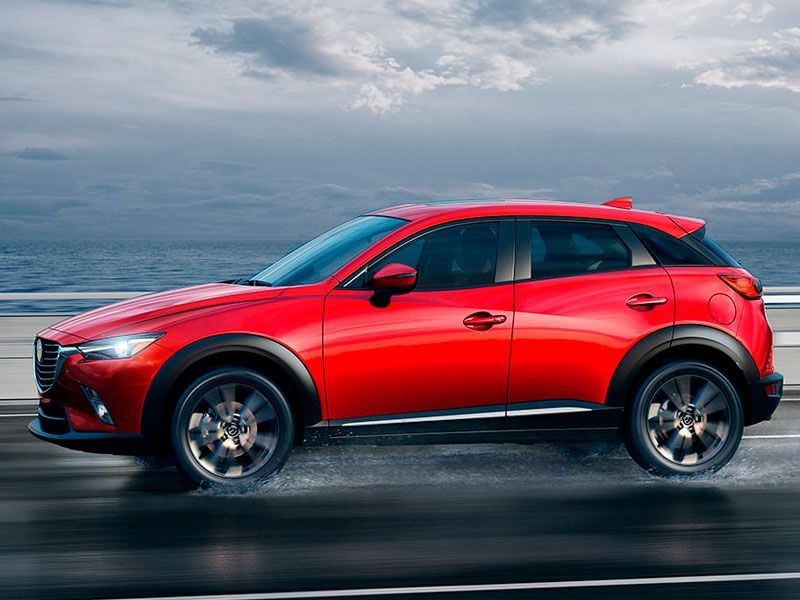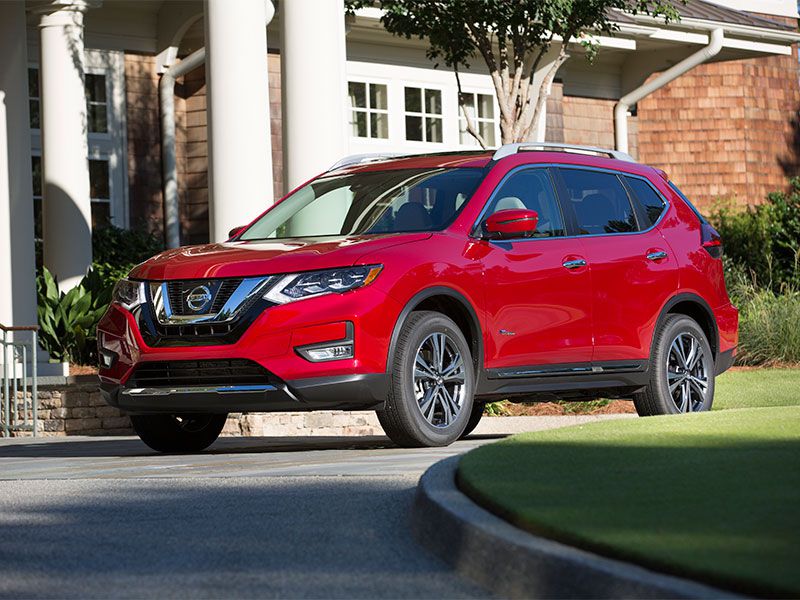Recent Articles
Popular Makes
Body Types
10 of the Safest Small SUVs

2016 BMW X1 ・ Photo by BMW
With SUVs as the family vehicle of choice these days, safety is obviously a big concern—after all, shouldn’t a family car protect your family? Many buyers are concerned about the crash performance of smaller vehicles, and with good reason, so we scoured the crash tests ratings to find ten compact and subcompact SUVs that will protect your family in a collision. Here is our list of 10 of the Safest Small SUVs, presented in alphabetical order.
2017 BMW X1
BMWs are known for good driving dynamics, but safety is also a high priority for the Bavarians, and that shows in the 2017 BMW X1. Though it hasn’t yet been crash-tested by the National Highway Traffic Safety Administration (NHTSA,) the X1 aced all of the the Insurance Institute for Highway Safety (IIHS)’s crash tests, though it needs to be equipped with optional front-collision avoidance features in order to earn that organization’s coveted Top Safety Pick award. From a driver’s perspective, the X1 is the good fun we expect from a BMW, though the back seat and cargo spaces are a bit tight and a long option list has the potential to drive the price way up.

Photo by BMW
2017 Fiat 500X
Fiat re-introduced themselves to the American market with the cute-and-cuddly 500, and now they have an SUV version. The 2017 FIAT 500X takes that same attractive facade and grafts it onto a five-seat SUV. But there’s more to the 500X than good looks, it’s also good on safety, with best-possible “Good” scores in all of the IIHS collision tests. (Though it’s been on the market for a couple of years, NHTSA does not have crash test results for the 500X.) Like the BMW X1, the FIAT 500X offers an optional collision detection system with automatic braking, and opting for it on a 500X gets it the IIHS’ Top Safety Pick title.

Photo by Fiat Chrysler Automobiles
2017 Honda CR-V
So far, we’ve talked about the Insurance Institute for Highway Safety’s Top Safety Pick award, but the 2017 Honda CR-V goes one better with a Top Safety Pick Plus. That award is reserved for vehicles that have perfect crash test scores, available collision-avoidance technology, and good headlights (though it’s worth noting that the latter two are optional on the Honda CR-V.) The CR-V also aced the government’s crash tests, with a five-star overall rating, five out of five stars for NHTSA front- and side-impact crashes and four out of five stars for rollover resistance (which is about as good as most SUVs get). Aside from its strong safety resume, the CR-V is an exceptionally likable vehicle with lots of space and good driving dynamics. No surprise that it’s been a best-seller for ages.

Photo by Honda
2017 Hyundai Tucson
There is a lot to like about the latest iteration of the Hyundai Tucson. This 2017 edition has smooth styling, is grown-up inside and out, nicely equipped, well appointed, and decent to drive (although there’s a bit of hesitation from the 1.6 liter turbo engine.) There’s another important reason to like it: it’s very safe. The Tucson scored a perfect five-star rating from NHTSA (with only four stars for rollover prevention, which is typical of SUVs) and a best-possible “Good” rating in all IIHS crash tests. Furthermore, if you opt for the extra-cost collision detection and automatic braking feature, it gets a Top Safety Pick from the IIHS as well. If you haven’t considered a Hyundai, you’d do well to test drive the new Tucson.

Photo by Hyundai
2017 Kia Sportage
We’ll admit to not being out-and-out fans of the new styling on the 2017 Kia Sportage, but there is still a lot about this compact SUV that deserves our praise. It’s closely related to the Hyundai Tucson, the praises of which we sang in the last slide, but we think it has better engine choices. Like the Tucson, it has a five-star overall rating from NHTSA and a Top Safety Pick from the IIHS provided you pay extra for the optional collision detection and automatic braking feature. The Kia Sportage is roomy, comfortable, decent to drive and most importantly, safe.

Photo by Kia
2017 Mazda CX-3
Most of the SUVs on this list are compacts, but we also wanted to include a subcompact which is where the 2017 Mazda CX-3 comes in. Diminutive as it is, the CX-3 does just as well as every other SUV on this list, with a five-star overall NHTSA rating and best-possible scores in all of the IIHS’ crash tests, plus it gets a Top Safety Pick Plus rating when equipped with the optional collision-mitigation system and upgraded headlights. The CX-3 is good fun to drive but tight on space, so if that’s a problem, check out Mazda’s one-size-bigger CX-5. It too has a Top Safety Pick Plus rating, and as a bonus, it comes with the collision-mitigation system as standard equipment.

Photo by Mazda
2017 Mitsubishi Outlander
Mitsubishi has become something of a minor player, with both the dealer network and model lineup shrinking—and that’s a shame because the compact 2017 Mitsubishi Outlander is a sensible choice. We like its comfortable interior and high-tech all-wheel-drive system, and we also love its safety scorecard. It only gets four stars from NHTSA for its front-crash rating, but the IIHS gives it a Top Safety Pick Plus rating with optional collision-mitigation system and headlights. We think the IIHS’ offset-barrier tests are closer to real-world collisions than tNHTSA’s front barrier crash, so we tend to give them more credence. The Outlander is a bit of an outsider in the market, but we think it’s well worth your consideration.

Photo by Mitsubishi
2017 Nissan Rogue
The 2017 Nissan Rogue is proving to be a hot seller and for many good reasons. It’s one of the smallest SUVs to feature a third-row seat, providing in-a-pinch seating for seven, and its upscale interior belies its affordable price. Safety is a strong point as well. Like the Mitsubishi Outlander, the Rogue only scores four out of five stars in NHTSA crash tests, but we’re more impressed with its strong scores across the board in the IIHS’ offset-deformable barrier tests (which, in our opinion, bear more similarities to a real-world crash.) Collision mitigation with automatic braking and adaptive headlights are optional on the Rogue, and when it is so equipped, it earns an IIHS Top Safety Pick Plus rating.

Photo by Nissan
2018 Subaru Forester
Subarus are old favorites with people who live in areas of the country where it rains and snows, but the brand is seeing a surge of new customers, largely in part to their latest ad campaign. Indeed, their vehicles are very crashworthy, and the 2018 Subaru Forester has both a five-star overall rating from NHTSA and perfect “Good” scores in all of the IIHS’ crash tests. Like several other SUVs on this list, the IIHS gives the Forester a Top Safety Pick Plus award when equipped with the automatic collision braking and adaptive headlight features, though it’s worth noting that these features are not available on some early-build 2017 Foresters.

Photo by Subaru
2017 Toyota RAV4
It’s no surprise to find the 2017 Toyota RAV4 on this list as it’s one of the longest-running small SUV nameplates on the market, and it continues to be a favorite with buyers. Though there are a lot of very safe SUVs on this list, the RAV4 has one key advantage: it comes with collision detection and automatic braking as standard, and that, along with its top-rank crash-test scores, make it an IIHS Top Safety Pick without any qualifiers. But the RAV4 also offers optional LED projector headlights with automatic high beams, and when it is so equipped, the Toyota RAV4 gets the IIHS’ Top Safety Pick Plus title.

Photo by Toyota